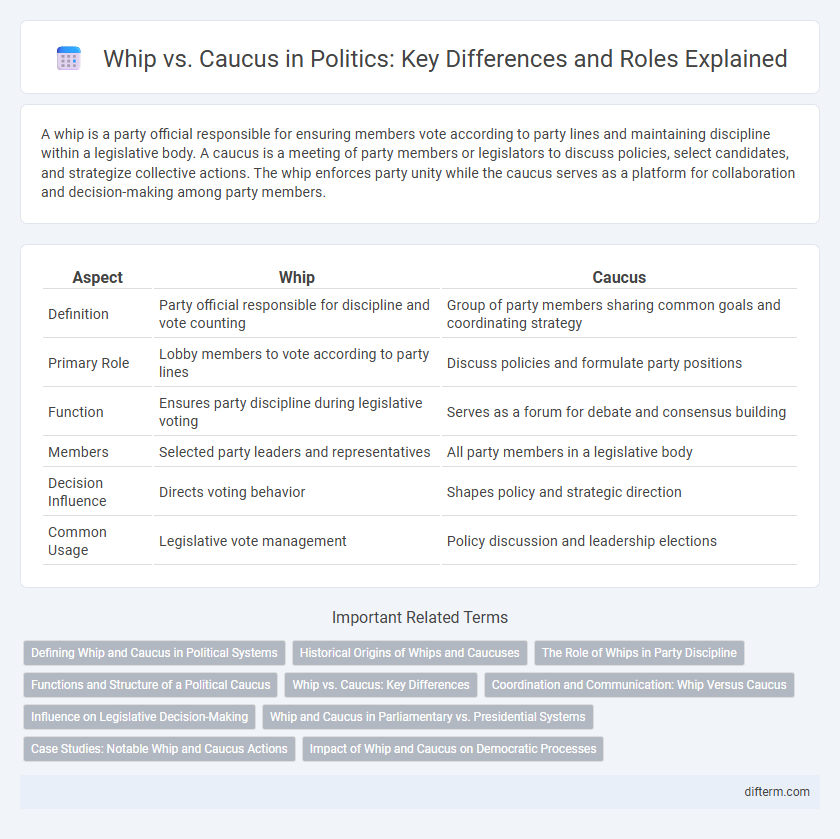A whip is a party official responsible for ensuring members vote according to party lines and maintaining discipline within a legislative body. A caucus is a meeting of party members or legislators to discuss policies, select candidates, and strategize collective actions. The whip enforces party unity while the caucus serves as a platform for collaboration and decision-making among party members.
Table of Comparison
| Aspect | Whip | Caucus |
|---|---|---|
| Definition | Party official responsible for discipline and vote counting | Group of party members sharing common goals and coordinating strategy |
| Primary Role | Lobby members to vote according to party lines | Discuss policies and formulate party positions |
| Function | Ensures party discipline during legislative voting | Serves as a forum for debate and consensus building |
| Members | Selected party leaders and representatives | All party members in a legislative body |
| Decision Influence | Directs voting behavior | Shapes policy and strategic direction |
| Common Usage | Legislative vote management | Policy discussion and leadership elections |
Defining Whip and Caucus in Political Systems
In political systems, a whip is a party official responsible for managing party discipline, ensuring members vote according to party lines, and maintaining communication between leadership and legislators. A caucus is a meeting or group of members from a particular political party or faction within a legislative body who coordinate policy positions, strategies, and candidate support. While whips enforce party cohesion, caucuses serve as platforms for discussion and collective decision-making among party members.
Historical Origins of Whips and Caucuses
Whips originated in the British Parliament during the 18th century as officials responsible for ensuring party discipline and managing legislative votes, a practice that was later adopted by other democratic systems. Caucuses, on the other hand, have roots in early American political history, evolving as informal meetings of party members to select candidates and coordinate strategy. Both whips and caucuses played crucial roles in shaping party organization and legislative cohesion throughout political history.
The Role of Whips in Party Discipline
Whips play a crucial role in maintaining party discipline by ensuring members vote according to party lines and attend key legislative sessions. They act as intermediaries between party leadership and rank-and-file legislators, gathering intelligence on member sentiment and persuading dissenting votes. Effective whip systems increase legislative cohesion and enhance a party's ability to pass policy agendas.
Functions and Structure of a Political Caucus
A political caucus functions as a meeting of party members or legislators to coordinate policies, select candidates, and strategize legislative agendas. The structure of a caucus typically includes elected leaders, such as a chairperson and secretaries, who organize discussions and ensure member participation, fostering unity and collective decision-making. Unlike the whip, whose role primarily enforces party discipline and manages voting behavior, the caucus serves as a collaborative forum to shape party platforms and build consensus.
Whip vs. Caucus: Key Differences
Whip and caucus serve distinct roles in legislative politics, with the whip acting as a party enforcer responsible for securing votes and maintaining discipline within the party. The caucus comprises all party members who meet to discuss policies, strategize, and select leaders, emphasizing collective decision-making. While the whip focuses on vote management and communication, the caucus prioritizes consensus-building and policy alignment among legislators.
Coordination and Communication: Whip Versus Caucus
The whip plays a crucial role in coordinating party members by ensuring attendance and securing votes on key legislation through direct communication and enforcement of party discipline. In contrast, the caucus serves as a broader forum for discussion, allowing members to share information, develop policy strategies, and build consensus through collective dialogue. Effective coordination within the party relies on the whip's operational communication tactics, while the caucus focuses on strategic communication to unify members around common goals.
Influence on Legislative Decision-Making
The whip plays a critical role in influencing legislative decision-making by enforcing party discipline and ensuring members' votes align with party strategies. In contrast, the caucus serves as a forum for collective discussion, shaping policy priorities and fostering consensus among party members before votes occur. This dynamic between the whip's vote management and the caucus's policy coordination ultimately directs legislative outcomes and party unity.
Whip and Caucus in Parliamentary vs. Presidential Systems
Whips in parliamentary systems enforce party discipline by ensuring legislators vote according to party lines, maintaining government stability and facilitating legislative agendas. Caucuses function as internal party groups that coordinate strategies, policy positions, and candidate support, often shaping party unity and legislative priorities. In presidential systems, whips have a more limited role due to separation of powers, while caucuses remain crucial for coalition-building and policy negotiation within congress.
Case Studies: Notable Whip and Caucus Actions
In U.S. politics, notable whip actions include Senator Mitch McConnell's strategic vote-counting efforts during the 2020 Supreme Court confirmation, which ensured party-line support. The House Democratic Caucus demonstrated significant influence in coordinating unified opposition to the 2017 tax reform bill, highlighting collective decision-making power. These case studies reveal the whip's role in vote management and the caucus's function in shaping party policy consensus.
Impact of Whip and Caucus on Democratic Processes
Whips play a crucial role in maintaining party discipline and ensuring legislators vote according to party agendas, thus streamlining legislative efficiency and reinforcing party unity. Caucuses foster collaboration among members with shared interests or identities, promoting diverse representation and facilitating collective policy advocacy that shapes legislative priorities. Together, whips and caucuses influence democratic processes by balancing party control with constituent-driven policymaking, enhancing both governance effectiveness and political accountability.
whip vs caucus Infographic

 difterm.com
difterm.com